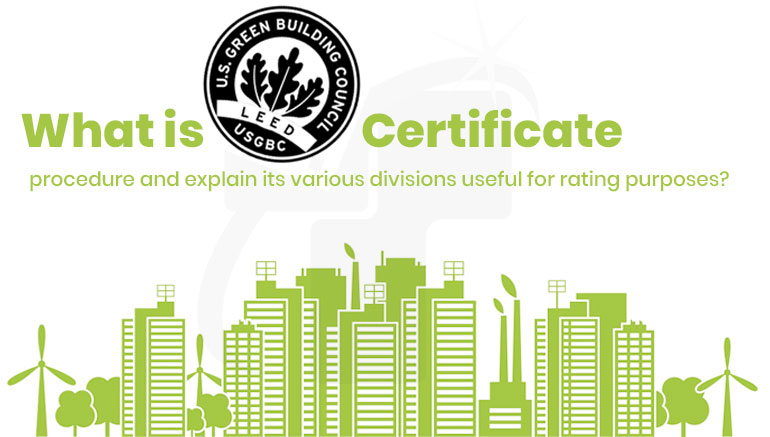What is LEED Certificate procedure and explain its various divisions useful for rating purposes?

LEED is Leadership in Energy and Environmental Design, which is a globally recognized rating system for the design, construction, operations, and maintenance of Green Building or Sustainable Building. It is a standard rating system that can be used for all building types, new construction projects, renovation projects to operation and maintenance of Green Building. This program is designed to inform and guide all kinds of construction professionals to create or convert spaces for sustainability aspects.
Table of Contents
LEED is a structure that the project team needs to apply to create a qualitative, coherent, and cost-effective green building as per building design standards. This certificate program is conducted under the authorities of the U.S GBC (United States Green Building Council) which helps to improve the performance under five areas such as environmental and human health, energy-efficient, indoor environmental quality, materials selection, sustainable site development, and water savings.
Benefits of LEED Certification
LEED Certification provides your clients and other construction professionals confirmation that your building has achieved environmental goals and is performing as per design. It allows you to take leverage state and local government incentives to boost interest in the projects.
The four levels of certification for new construction projects drive the number of credits accrued in the category of sustainability, water efficiency, energy and atmosphere, materials, resources, and indoor air quality.
LEED Standards cover new construction projects, Scan to BIM Services for renovation projects, interiors, and exteriors, and existing building operations. It is mostly to include Core & Shell construction, new home construction, and neighborhood development.
Divisions in LEED Certificate Procedure
LEED has several divisions to gain points for earning a rating for commencing the project. The divisions are as follows:-

Innovation in Design (ID):- Making the construction buildings sustainable is the biggest challenge these days in terms of design and usage of materials which is constantly evolving and new technologies have induced into the markets. This division offers credits to the building, which has the most innovative features in the form of design and sustainable building practices.
Location and Linkages (LL):- It focuses on the reduction of impact created by greenhouse gas emissions, pollution, and depletion of resources that avoid development in environmental areas. It encourages the development of locations to have multi-modal transportation choices, so that greenhouse gas emissions and environmental harms caused due to motor vehicle usage need to be reduced.
Sustainable Sites (SS):- It emphasizes the surrounding of the building to make it environment-friendly. It ensures the preservation of biodiversity and the reduction of pollution from construction activities. An ecosystem is protected by proper planning of the locations of the buildings to avoid harming the water bodies and natural habitats. Adequate measures need to be taken to re-mediate areas on the project site, which cause harm to the ecosystem.
Water Efficiency (WE):- The reduction of indoor and outdoor water consumption measures is taken in this category. Rewards are given as the measure taken for the use of water through alternative sources like rainwater. Steps taken for the reduction of wastewater by the installation of efficient plumbing fixtures and installations of systems that recycle water are given reward points.
Energy and Atmosphere (EA):- Reduction in energy use and use of renewal energy sources is considered here. Designs are made in order to get a reduction in overall energy needs, such as climate conditions and building materials. Measures such as natural ventilation and HVAC systems reduce a building’s energy usage. The creation of renewable energy is obtained.
Materials and Resources (MR):- It emphasizes the reduction of waste generated during construction. In a construction project, the most important thing would be building materials and reuse of materials to reduce wastage can be effective measures to be taken for avoiding any harm to the environment. In an urban area, landfill space reached the capacity to increase the transportation cost of waste management. By recycling, the storage of waste in landfills can be prevented.
Indoor Environmental Quality (EQ):- It focuses on the improvement of indoor air quality by reducing air pollution with the use of Energy Star Appliances and ventilation measures. It is done by following proper HVAC BIM Services strategies. Indoor factors such as weather conditions, and site location, and outdoor factors such as industrial emissions and noise pollution are taken into account to develop a plan for ensuring a high level of indoor air quality.
Awareness and Education (EA):- It encourages home builders to educate owners to make sure they take appropriate measures to avoid environmental damage.
Types of a project to be conducted in LEED for rating measurement
LEED provides appropriate ratings for the kinds of projects stated below:-

Example of LEED rating in India
Below are examples of LEED ratings given in India for the projects.
| Building | Location | LEED Rating |
| Suzlon One Earth | Pune | Platinum |
| I-Gate Knowledge Centre | Noida | Platinum |
| Infinity Benchmark | Kolkata | Platinum |
| Infosys Ltd | Mysore | Platinum |
| Olympia Tech Park | Chennai | Gold |
Type and pricing of LEED Certification
The types of LEED Accreditation LEED rating help to achieve better building projects. A number of credits when attained make the project get LEED Certificate on the project commenced that is spread across Supply Chain Management, Environmental Sites, Water Efficiency, Energy & Atmosphere, Materials & Resources, Indoor Environmental Quality, Innovation, and more. There are four levels for LEED rating certification as stated below:-

Pricing of LEED Certification

Conclusion
LEED aims to provide its contribute to global climate change to protect and restore natural resources. It enhances individual human health and well-being to encourage sustainable practices to build a greener economy. It protects, improves, and restores biodiversity.
LEED can be used for various purposes but for commercial and residential buildings it can be used for higher resale value, faster lease-up rates, healthier indoor space, and lowering the consumption of energy, water, and other resources. It is better for the health of the occupants, the community, and the environment.

